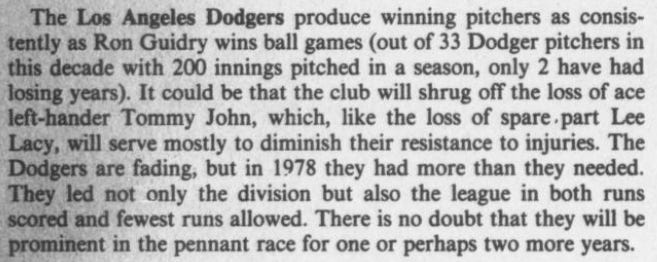What Happened to the 1979 Dodgers?
The Los Angeles Dodgers must have seemed like a team of destiny in the late 1970s.
After years of fighting with the Cincinnati Reds for National League West supremacy, the Dodgers finally came out on top in 1977. They followed that World Series appearance with another trip to October in 1978.
And, as you probably already know, the Dodgers made it to a one game playoff with Houston in 1980, wound up winning the whole thing in 1981, finished only a game behind Atlanta in 1982, and regained control of the National League West in 1983.
Add in an NLCS appearance in 1985 and another World Series victory in 1988, and you’ve got a team that was more or less dominant for the better part of a decade.
But what happened in 1979?
Bill James certainly thought the Dodgers would be good in his 1979 Major League Baseball preview, printed in the April 24, 1979 issue of Esquire (starting on page 64, for those of you keeping score). James started his preview off with this somewhat ominous note:
And James was right. The Dodgers had a lineup filled with guys in their late 20s and early 30s in 1978, and had a bench filled with guys pushing 40.
However, even the loss of Tommy John via free agency to the hated Yankees didn’t make James think that they’d be any worse:
In reality, the Dodgers finished at an abysmal 79-83, good enough for 3rd place in a poor division. They were 11 1/2 games behind the Reds.
So what happened?
Rick Monday got hurt. The 33-year old Monday was limited to only 12 games in 1979, after putting out a 128 OPS+ and 1.7 WAR in 119 games in 1978. Monday was probably a tad overrated offensively, and seems to have been somewhat of a liability defensively — but Derrel Thomas, who replaced him in the lineup, was nothing short of terrible.
The team was too old. Monday stuck around for a few more years, sure. But the 1979 Dodgers gave playing time to the likes of 41 year old Manny Mota and 39 year old Vic Davalillo, two players who were well past their prime. Now, not all of the old guys were bad. Davey Lopes, for example, had a good season at age 34, and wound up having another 8 seasons in him before he finally hung up his spikes. But one thing that stands out about the 1979 Dodgers is the complete lack of talented young players in the lineup or on the bench — aside from Mickey Hatcher and Pedro Guerrero, that is.
They had no fifth starter. Now, technically, the majority of Major League Baseball teams have a hard time finding a fifth starting pitcher. But the 1979 Dodgers really struggled in that category. Don Sutton, Rick Sutcliffe (only 23 years old, mind you), Burt Hooton, and Jerry Reuss had somewhere between 20 and 30 starts each. The rest went to established names who were having bad years: Andy Messersmith (4.91 ERA), Doug Rau (5.30), and Charlie Hough (4.76). Bob Welch, at only 22 years old, started 12 games on and off, but his alcohol problem went out of control, and he wound up checking into a rehab center sometime in July. The foundation for the future was there, sure (and 1979 is when they signed Valenzuela), but it was going to take a while to get to that future.
Their bullpen was bad. Charlie Hough pitched mostly out of the bullpen in 1979 and wasn’t impressive at all. 22 year old Dave Patterson, who had led the 1978 Texas League in saves over the likes of Lee Smith, Jeff Reardon, Dave Righetti, and Mark Clear, was allowed to pitch 53 innings in the majors after he came up in early June. He impressed nobody, and never had another chance at the big leagues. The rest of the bullpen was generally poor and ineffective.
There were a few other issues. Reuss, who the Dodgers had obtained from the Pirates in exchange for Doug Rau, had much better years ahead of him. But, by the same token, Sutcliffe was more than capable of filling in the hole left by Tommy John’s departure.
It might just have been a case of bad luck. And, sure, third place isn’t awful — though you might think differently when you realize that the Dodgers spent most of the season in 5th and 6th place.





Mota and Davalillo were PH only and had been for years with LA. I don't think they even took the field once.
This is, perhaps, a good example of a perception I have that stats can be excellent in analyzing what has already happened but rather suspect in predicting what will happen. Unanticipated injuries, for example, can make predictions worthless. That said, as I understand it, modern advanced sabermetrics have gotten very good at prediction. (Yet I still think good old run differential is a good predictor.)
I like the line, "the rich grow richer and the poor grow livestock for the rich." Seems particularly apropos these days.